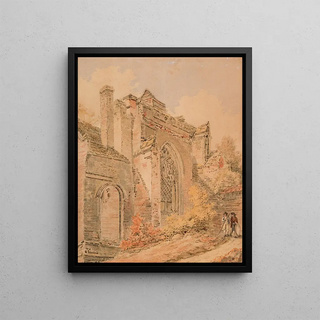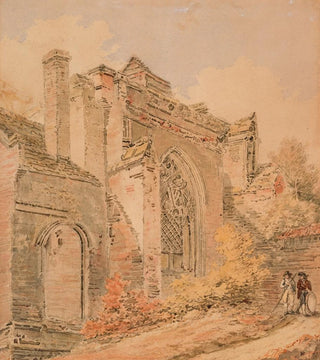Art print | Abbey of Saint Albans, Hertfordshire - Joseph Mallord William Turner


View from behind

Frame (optional)
Abbaye de Saint Albans, Hertfordshire - Joseph Mallord William Turner – Captivating introduction
The artwork "Abbaye de Saint Albans, Hertfordshire" by Joseph Mallord William Turner is part of a pivotal moment in art history, where light and atmosphere take precedence over realistic representation. Turner, often regarded as a precursor to Impressionism, manages to capture the very essence of a place, transcending mere landscape to evoke deep emotions. In this art print, the abbey, majestic and steeped in history, stands as a silent witness to bygone eras, enveloped in a diffuse light that seems to tell forgotten stories. The piece invites meditative contemplation, transporting the viewer to the heart of this Gothic architecture, while offering a unique sensory experience.
Style and uniqueness of the artwork
Turner, master of color and light, employs delicate nuances to bring his subject to life. In "Abbaye de Saint Albans, Hertfordshire," pastel shades blend with bursts of light, creating an atmosphere that is both serene and mysterious. The architectural details of the abbey merge into a swirling sky, where clouds animate under the influence of changing light. This treatment of light, almost spiritual, gives the work a timeless dimension. Turner does not merely depict a building; he reveals its soul, connecting it to the surrounding nature. The harmony between architecture and landscape is a key characteristic of his style, inviting reflection on the relationship between man and his environment.
The artist and his influence
Joseph Mallord William Turner, often nicknamed the "painter of light," is an iconic figure of British Romanticism. Born in London, he consistently challenged the artistic conventions of his time throughout his career. His works, marked by heightened sensitivity to atmospheric effects, influenced many artists, especially those of the Impressionist movement. Turner was able to capture the ephemeral, transforming ordinary scenes into striking visual experiences. His ability to evoke emotions through constantly evolving landscapes has

Matte finish

View from behind

Frame (optional)
Abbaye de Saint Albans, Hertfordshire - Joseph Mallord William Turner – Captivating introduction
The artwork "Abbaye de Saint Albans, Hertfordshire" by Joseph Mallord William Turner is part of a pivotal moment in art history, where light and atmosphere take precedence over realistic representation. Turner, often regarded as a precursor to Impressionism, manages to capture the very essence of a place, transcending mere landscape to evoke deep emotions. In this art print, the abbey, majestic and steeped in history, stands as a silent witness to bygone eras, enveloped in a diffuse light that seems to tell forgotten stories. The piece invites meditative contemplation, transporting the viewer to the heart of this Gothic architecture, while offering a unique sensory experience.
Style and uniqueness of the artwork
Turner, master of color and light, employs delicate nuances to bring his subject to life. In "Abbaye de Saint Albans, Hertfordshire," pastel shades blend with bursts of light, creating an atmosphere that is both serene and mysterious. The architectural details of the abbey merge into a swirling sky, where clouds animate under the influence of changing light. This treatment of light, almost spiritual, gives the work a timeless dimension. Turner does not merely depict a building; he reveals its soul, connecting it to the surrounding nature. The harmony between architecture and landscape is a key characteristic of his style, inviting reflection on the relationship between man and his environment.
The artist and his influence
Joseph Mallord William Turner, often nicknamed the "painter of light," is an iconic figure of British Romanticism. Born in London, he consistently challenged the artistic conventions of his time throughout his career. His works, marked by heightened sensitivity to atmospheric effects, influenced many artists, especially those of the Impressionist movement. Turner was able to capture the ephemeral, transforming ordinary scenes into striking visual experiences. His ability to evoke emotions through constantly evolving landscapes has






